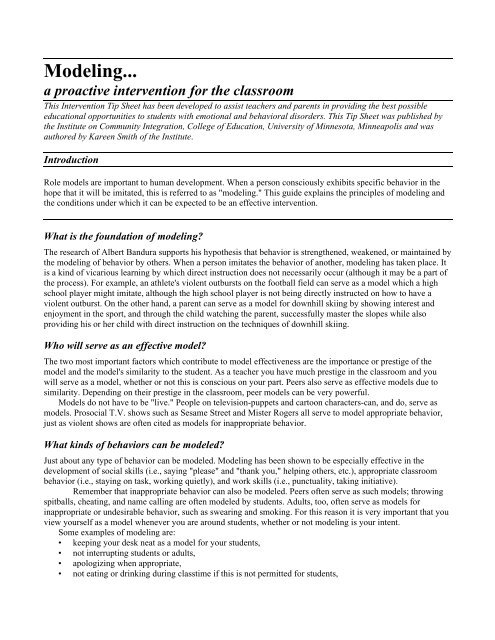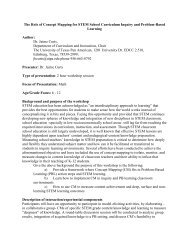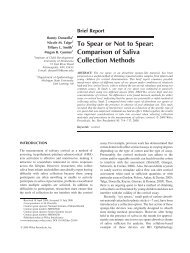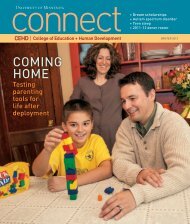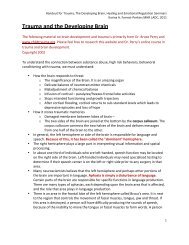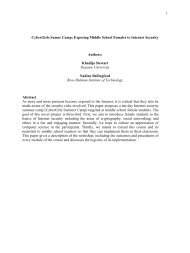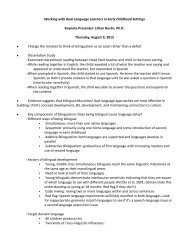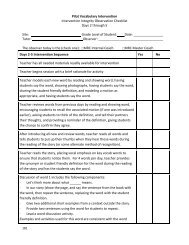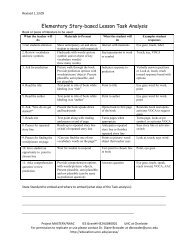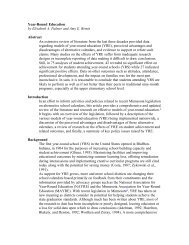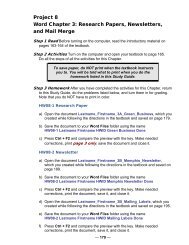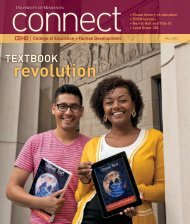Introduction to Positive Ways of Intervening with Challenging Behavior
Introduction to Positive Ways of Intervening with Challenging Behavior
Introduction to Positive Ways of Intervening with Challenging Behavior
Create successful ePaper yourself
Turn your PDF publications into a flip-book with our unique Google optimized e-Paper software.
Modeling...<br />
a proactive intervention for the classroom<br />
This Intervention Tip Sheet has been developed <strong>to</strong> assist teachers and parents in providing the best possible<br />
educational opportunities <strong>to</strong> students <strong>with</strong> emotional and behavioral disorders. This Tip Sheet was published by<br />
the Institute on Community Integration, College <strong>of</strong> Education, University <strong>of</strong> Minnesota, Minneapolis and was<br />
authored by Kareen Smith <strong>of</strong> the Institute.<br />
<strong>Introduction</strong><br />
Role models are important <strong>to</strong> human development. When a person consciously exhibits specific behavior in the<br />
hope that it will be imitated, this is referred <strong>to</strong> as "modeling." This guide explains the principles <strong>of</strong> modeling and<br />
the conditions under which it can be expected <strong>to</strong> be an effective intervention.<br />
What is the foundation <strong>of</strong> modeling?<br />
The research <strong>of</strong> Albert Bandura supports his hypothesis that behavior is strengthened, weakened, or maintained by<br />
the modeling <strong>of</strong> behavior by others. When a person imitates the behavior <strong>of</strong> another, modeling has taken place. It<br />
is a kind <strong>of</strong> vicarious learning by which direct instruction does not necessarily occur (although it may be a part <strong>of</strong><br />
the process). For example, an athlete's violent outbursts on the football field can serve as a model which a high<br />
school player might imitate, although the high school player is not being directly instructed on how <strong>to</strong> have a<br />
violent outburst. On the other hand, a parent can serve as a model for downhill skiing by showing interest and<br />
enjoyment in the sport, and through the child watching the parent, successfully master the slopes while also<br />
providing his or her child <strong>with</strong> direct instruction on the techniques <strong>of</strong> downhill skiing.<br />
Who will serve as an effective model?<br />
The two most important fac<strong>to</strong>rs which contribute <strong>to</strong> model effectiveness are the importance or prestige <strong>of</strong> the<br />
model and the model's similarity <strong>to</strong> the student. As a teacher you have much prestige in the classroom and you<br />
will serve as a model, whether or not this is conscious on your part. Peers also serve as effective models due <strong>to</strong><br />
similarity. Depending on their prestige in the classroom, peer models can be very powerful.<br />
Models do not have <strong>to</strong> be "live." People on television-puppets and car<strong>to</strong>on characters-can, and do, serve as<br />
models. Prosocial T.V. shows such as Sesame Street and Mister Rogers all serve <strong>to</strong> model appropriate behavior,<br />
just as violent shows are <strong>of</strong>ten cited as models for inappropriate behavior.<br />
What kinds <strong>of</strong> behaviors can be modeled?<br />
Just about any type <strong>of</strong> behavior can be modeled. Modeling has been shown <strong>to</strong> be especially effective in the<br />
development <strong>of</strong> social skills (i.e., saying "please" and "thank you," helping others, etc.), appropriate classroom<br />
behavior (i.e., staying on task, working quietly), and work skills (i.e., punctuality, taking initiative).<br />
Remember that inappropriate behavior can also be modeled. Peers <strong>of</strong>ten serve as such models; throwing<br />
spitballs, cheating, and name calling are <strong>of</strong>ten modeled by students. Adults, <strong>to</strong>o, <strong>of</strong>ten serve as models for<br />
inappropriate or undesirable behavior, such as swearing and smoking. For this reason it is very important that you<br />
view yourself as a model whenever you are around students, whether or not modeling is your intent.<br />
Some examples <strong>of</strong> modeling are:<br />
• keeping your desk neat as a model for your students,<br />
• not interrupting students or adults,<br />
• apologizing when appropriate,<br />
• not eating or drinking during classtime if this is not permitted for students,


